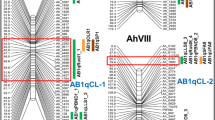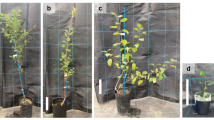Abstract
We conducted a 2-year field assessment of the gene flow from genetically modified (GM) chili pepper (Capsicum annuum L.), containing the PepEST (pepper esterase) gene, to a non-GM control line “WT512” and two commercial hybrid cultivars, “Manidda” and “Cheongpung Myeongwol (CM).” After seeds were collected from the pollen-recipient non-GM plants, hybrids between them and the GM peppers were screened by a hygromycin assay. PCR with the targeting hpt gene was performed to confirm the presence of transgenes in hygromycin-resistant seedlings. Out of 7,071 “WT512” seeds and 6,854 “Manidda” seeds collected in 2006, eight and 12 hybrids, respectively, were detected. In 2007, 33 hybrids from 3,456 “WT512” seeds and 50 hybrids from 3,457 “CM” seeds were found. The highest frequency of gene flow, 6.19%, was observed in that 2007 trial. These results suggest that a limited isolation distance would be sufficient to prevent gene flow from GM to conventionally bred chili peppers.





Similar content being viewed by others
References
Bosland PW (1993) An effective plant field cage to increase the production of genetically pure chile (Capsicum spp.) seed. HortScience 28:1053
Campodonico OP (1983) Estimates of natural cross-pollination in serrano pepper (Capsicum annuum L.). Capsicum Newsletter 2:106–108
CFIA (Canadian Food Inspection Agency) (2000) Regulatory Directive 2000-07: Guidelines for the Environmental Release of Plants with Novel Traits within Confined Field Trials in Canada. CFIA, Ottawa, Canada
Delaplane KS, Mayer DF (2000) Crop pollination by bees. CABI Publishing, Wallingford, UK
Free JB (1993) Insect pollination of crops. Academic, London
Heiser CB Jr, Smith PG (1953) The cultivated Capsicum peppers. Econ Bot 7:214–227
Kim YS, Lee HH, Ko MK, Song CE, Bae C-Y, Lee YH, Oh B-J (2001) Inhibition of fungal appressorium formation by pepper (Capsicum annuum) esterase. MPMI 14:80–85
Kim YS, Ko MK, Seo HH, Cho JH, Song P-S (2006) Fungal resistant transgenic pepper plants and their production method. United States Patent Application Publication No. US2006/0037100 A1
Kim C-G, Lee B, Kim DI, Park JE, Kim H-J, Park KW, Yi H, Jeong S-C, Yoon WK, Harn CH, Kim HM (2008) Detection of gene flow from GM to non-GM watermelon in a field trial. J Plant Biol 51:74–77
Kim C-G, Park KW, Lee B, Kim DI, Park J-Y, Kim H-J, Park JE, An JH, Cho K-H, Jeong S-C, Choi KH, Harn CH, Kim HM (2009) Gene flow from genetically modified to conventional chili pepper (Capsicum annuum L.). Plant Sci 176:406–412
Ko MK, Jeon WB, Kim KS, Lee HH, Seo HH, Kim YS, Oh B-J (2005) A Colletotrichum gloeosporioides-induced esterase gene of nonclimacteric pepper (Capsicum annuum) fruit during ripening plays a role in resistance against fungal infection. Plant Mol Biol 58:529–541
Korea Meteorological Administration (2009) Climate data. http://www.kma.go.kr/gw.jsp?to=/weather_main.jsp, Accessed 19 January 2009
Llewellyn D, Fitt G (1996) Pollen dispersal from two field trials of transgenic cotton in the Namoi Valley, Australia. Mol Breed 2:157–166
McPartlan HC, Dale PJ (1994) An assessment of gene transfer by pollen from field-grown transgenic potatoes to non-transgenic potatoes and related species. Transgenic Res 3:216–225
Murashige T, Skoog F (1962) A revised medium for rapid growth and bioassay with tobacco tissue cultures. Physiol Plant 5:473–479
OECD (2006) Consensus Document on the Biology of Capsicum annuum Complex (Chili Peppers, Hot Peppers and Sweet Peppers). Series on Harmonisation of Regulatory Oversight in Biotechnology No. 36. Organisation for Economic and Co-operation and Development, Paris
Perry L, Dickau R, Zarrillo S, Holst I, Pearsall DM, Piperno DR, Berman MJ, Cooke RG, Rademaker K, Ranere AJ, Raymond JS, Sandweiss DH, Scaramelli F, Tarble K, Zeidler JA (2007) Starch fossils and the domestication and dispersal of chili peppers (Capsicum spp. L.) in the Americas. Science 315:986–988
Pickersgill B (1997) Genetic resources and breeding of Capsicum spp. Euphytica 96:129–133
Rabinowitch HD, Fahn A, Meir T, Lensky Y (1993) Flower and nectar attributes of pepper (Capsicum annuum L.) plants in relation to their attractiveness to honeybees (Apis mellifera L.). Ann Appl Biol 123:221–232
Saxena P, Vijayaraghavan MR, Sarbhoy RK, Raizada U (1996) Pollination and gene flow in chillies with Scirtothrips dorsalis as pollen vectors. Phytomorphology 46:317–327
Shipp JL, Whitfield GH, Papadopoulos AP (1994) Effectiveness of the bumble bee, Bombus impatiens Cr. (Hymenoptera: Apidae), as a pollinator of greenhouse sweet pepper. Sci Hortic 57:29–39
Tanksley SD (1984) High rates of cross-pollination in chile pepper. HortScience 19:580–582
Umbeck PF, Barton KA, Nordheim EV, McCarty JC, Parrott WL, Jenkins JN (1991) Degree of pollen dispersal by insects from a field test of genetically engineered cotton. J Econ Entomol 84:1943–1950
Yoon JB, Yang DC, Lee WP, Ahn SY, Park HG (2004) Genetic resources resistant to anthracnose in the genus Capsicum. J Korean Soc Hort Sci 45:318–323
Yoshimura Y, Matsuo K, Yasuda K (2006) Gene flow from GM glyphosate-tolerant to conventional soybeans under field conditions in Japan. Environ Biosafety Res 5:169–173
Acknowledgments
We thank Dr. H.T. Kim at the Chungbuk National University for providing seeds of “Cheongpung Myeongwol.” This research was supported by grants from the KRIBB Research Initiative Program and the Crop Functional Genomics Center.
Author information
Authors and Affiliations
Corresponding author
Rights and permissions
About this article
Cite this article
Kim, CG., Kim, D.I., Kim, HJ. et al. Assessment of Gene Flow from Genetically Modified Anthracnose-Resistant Chili Pepper (Capsicum annuum L.) to a Conventional Crop. J. Plant Biol. 52, 251–258 (2009). https://doi.org/10.1007/s12374-009-9025-y
Received:
Revised:
Accepted:
Published:
Issue Date:
DOI: https://doi.org/10.1007/s12374-009-9025-y




